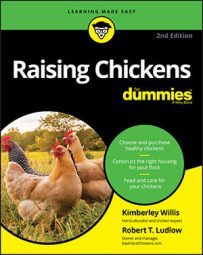In chickens, selective breeding using the smallest birds of each generation has produced small breeds called bantams. A few breeds have some dwarf genes. People have always enjoyed seeing miniature versions of domestic animals. Bantam chickens are primarily kept for show or as pets, as are most other small versions of domestic animals.
Almost every standard chicken breed has bantam varieties, and some bantam breeds exist only in the small size. When the bantam has a full-size counterpart, the breed description is basically the same, except that the bantams are much smaller. When a chicken has no full-size representative, it is called a true bantam.
![[Credit: Illustration by Barbara Frake]](https://www.dummies.com/wp-content/uploads/470050.image0.jpg)
Bantams are seldom heavy layers, but the small eggs are still good to eat and taste exactly like other chicken eggs. The eggs are the same color as eggs laid by a full-size example of the breed. However, bantams do not make good meat birds. Because most bantam breeds look just like the full-size version of the breed, only true bantams are described here — breeds that don’t have full-size counterparts:
Silkie: The Silkie is probably one of the most popular pet chickens. Silkies may be quite small or a bit larger, but all have distinctive furlike feathers. They’re so cute that you may want to cuddle them, and some don’t mind being handled. Some have beards, and they come in black, blue, white, buff, and other colors.
The skin of Silkies is black, and their combs and earlobes are dark maroon-red, with a turquoise area around the ear. Silkies are the ultimate mothers. They love to sit on eggs and happily raise anyone’s babies. They’re sometimes picked on by more active breeds. Silkies lay white eggs.
Japanese: The Japanese bantam has tiny, short legs and a high, arched tail, often in a color that contrasts with the body. It comes in many colors and color combinations and weighs about a pound. Most Japanese bantams are friendly, although the roosters sometimes get mean. Japanese bantams lay white eggs.
Serama: The Serama bantam is the smallest chicken breed in the world (about 1 pound or less) and one of the newest, developed in only the last 50 years. Chickens from this breed can be hard to find and expensive. The tiny birds have an odd V shape to them, with a full breast held very upright and a tail carried straight up.
The wings point down and touch the ground. Seramas come in a variety of colors, and there is a Silkie feathered variation, too. The tiny chicks need to be raised with special care, and the birds are not cold hardy; they require heated housing in the winter.
Sebright: The Sebright bantams come in gold and silver as base colors. Each feather is outlined in black, making a pretty pattern. They can be hard to sex because the roosters and hens look so similar. Sebrights have a rose comb (short and crumbled looking) that comes to a spike point in the back. They’re active birds and can be aggressive with each other.
Antwerp Belgian Bantam: These birds are very small. They have a rose comb like the Sebright, a muff of feathers around the ear lobe, and a fluffy beard under their beak. They come in several colors and are active and friendly little birds.
Mille Fleur: The color of Mille Fleurs is hard to describe. The base feather color is reddish-gold over the body and wings, with black on the feet and tail. But each feather has a white dot on the end and then a black area, giving the bird a spangled appearance. The feet of Mille Fleurs are covered in feathers, or “booted.”
The breed has two subvarieties: bearded and nonbearded. Bearded birds have muffs of feathers under the earlobes and a beard that runs under the beak. These beautiful little birds make excellent pets.
Porcelain: These tiny bantams are much like the Mille Fleur, with bearded and nonbearded categories. The color of the Porcelain is pale yellow with a blue area just before the white “spangle” on the feather tip. The tail and feet feathers are blue-gray tipped in white. These birds are quiet and gentle.

